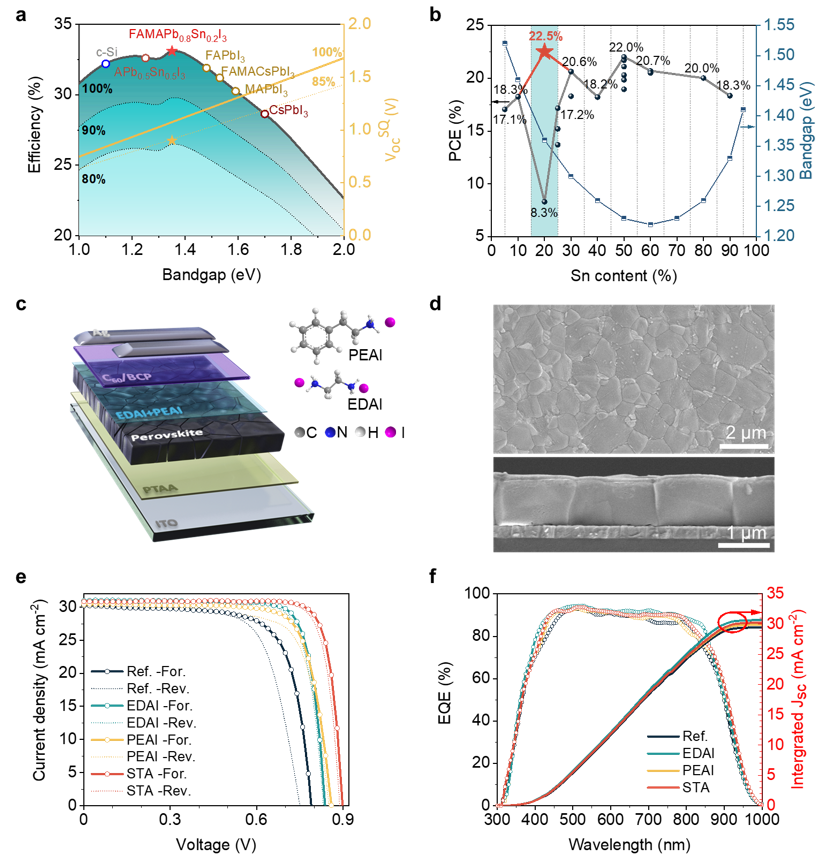Researchers from the Hefei Institutes of Physical Science (HFIPS) of the Chinese Academy of Sciences have come up with a novel solution to address bimetallic traps in high-efficiency perovskite solar cells (PSCs) by employing an anchoring strategy.
 Figure 1. a. S-Q limit efficiencies and open-circuit voltage of different compositions; b. Summary of recent works of LTPSCs and the bandgap variation versus Sn content ratio (blue line); c. Diagram of device structure, inserted graph is chemical structure of anchor molecules; d. Surface-view and cross-sectional SEM images after selective targeting anchor treatment; e. Forward and reverse scan for J-V curves of the reference, ethylenediamine diiodide, phenethylammonium iodide and selective targeting anchor device; f. EQE plots and derived integrated JSC of the reference, ethylenediamine diiodide, phenethylammonium iodide and selective targeting anchor device. Image Credit: Jiajiu Ye.
Figure 1. a. S-Q limit efficiencies and open-circuit voltage of different compositions; b. Summary of recent works of LTPSCs and the bandgap variation versus Sn content ratio (blue line); c. Diagram of device structure, inserted graph is chemical structure of anchor molecules; d. Surface-view and cross-sectional SEM images after selective targeting anchor treatment; e. Forward and reverse scan for J-V curves of the reference, ethylenediamine diiodide, phenethylammonium iodide and selective targeting anchor device; f. EQE plots and derived integrated JSC of the reference, ethylenediamine diiodide, phenethylammonium iodide and selective targeting anchor device. Image Credit: Jiajiu Ye.
The study has been published in the Advanced Materials journal.
In the reported ideal bandgap PSCs, a record power conversion efficiency (PCE) of 22.51% was obtained.
The bandgap of plumbum (Pb/lead)-based perovskite materials varies from 1.5 eV to 1.7 eV. The power conversion efficiency peaks at a bandgap of 1.33 eV as per the Shockley-Queisser (S-Q) model that was evaluated and suggested by William Shockley and Hans Queisser in 1961.
Taking this into account, the scientists attempted to decrease the bandgap of the theoretically highest PCE to 1.33 eV by partially or completely replacing Pb with stannum (Sn/tin). When Sn was added directly up to 20% without any doping, the bandgap did drop to around 1.33 eV. However, 20% Sn brought a new issue of a massive open-circuit voltage loss.
The voltage loss is mainly due to bimetallic traps.
Xu Pan, Study Lead and Researcher, Hefei Institutes of Physical Science, Chinese Academy of Sciences
Pan has specialized in perovskite solar cells for many years at HFIPS.
In reality, bimetallic traps are caused by the majority of the intense turbulence of energy and crystal structure, and PAN’s team decided to accept a targeting anchor plan to stop this turbulence.
Initially, the researchers synthesized a bromine-free lead-tin perovskite material with a bandgap of 1.33 eV. Furthermore, they established an anchoring plan that phenethylammonium iodide and ethylenediamine diiodide were introduced as “co-modifier,” which selectively anchors with Pb- and Sn-related active sites, and “passivating bimetallic traps.”
Moreover, the energetic depth specificity of Pb- and Sn-related traps has been clearly illustrated in the selective mechanism of molecular orientation anchor passivation.
After adopting the strategy, the researchers were astonished to see that the open-circuit voltage increased from 0.79 V to 0.90 V. Also, the conversion efficiency reached 22.51%.
I think our work may reveal metal dual source defects in lead-tin perovskite solar cells.
Xu Pan, Study Lead and Researcher, Hefei Institutes of Physical Science, Chinese Academy of Sciences
Pan anticipates that their work could offer useful passivation mechanisms in response to bimetallic traps.
This study was financially supported by the National Key R&D Project of China and the Science Funds of Distinguished Young Scholars of Anhui Province.